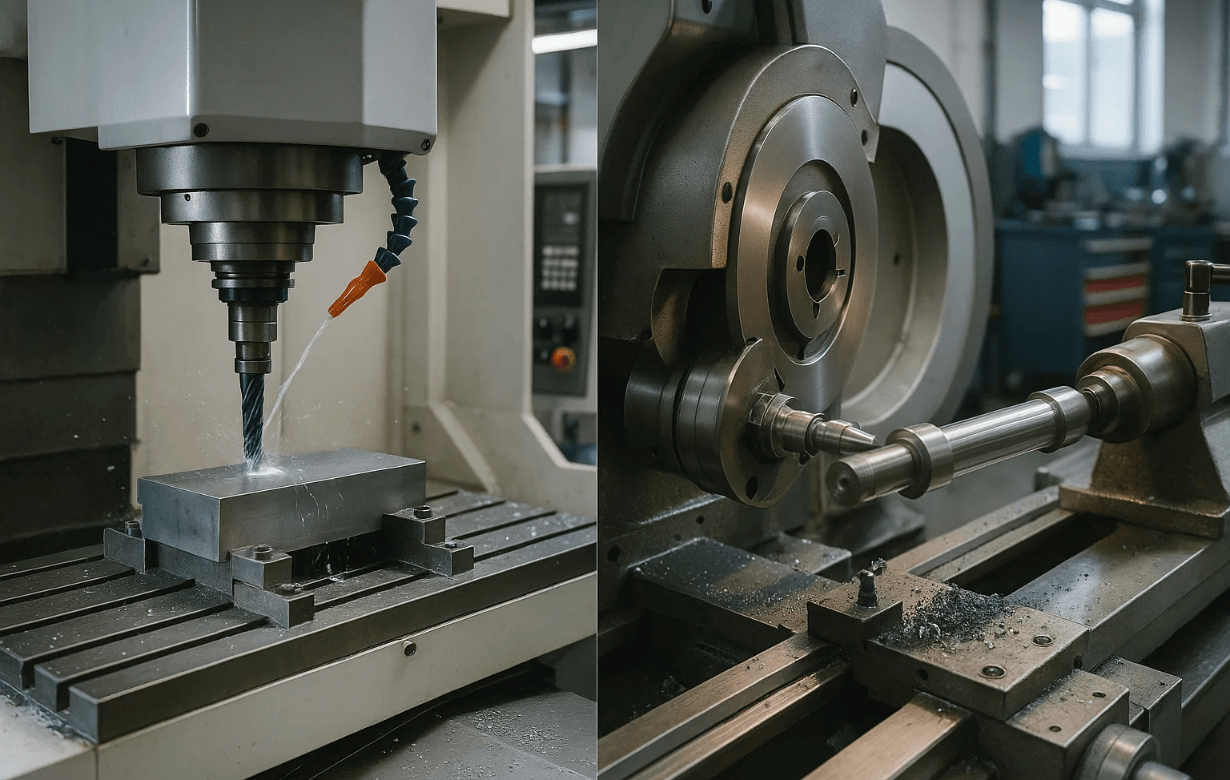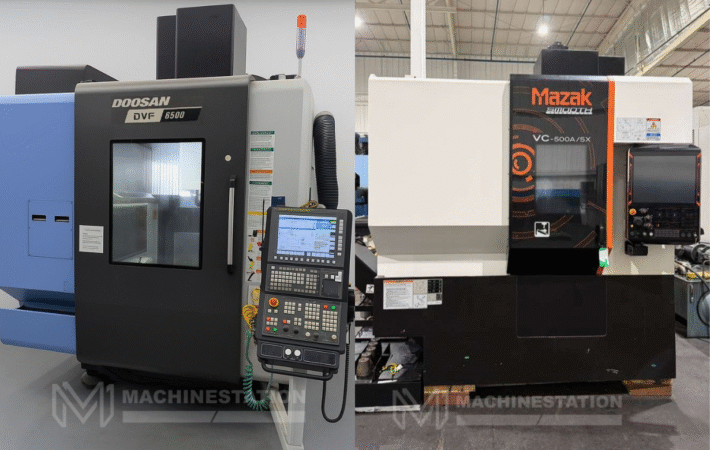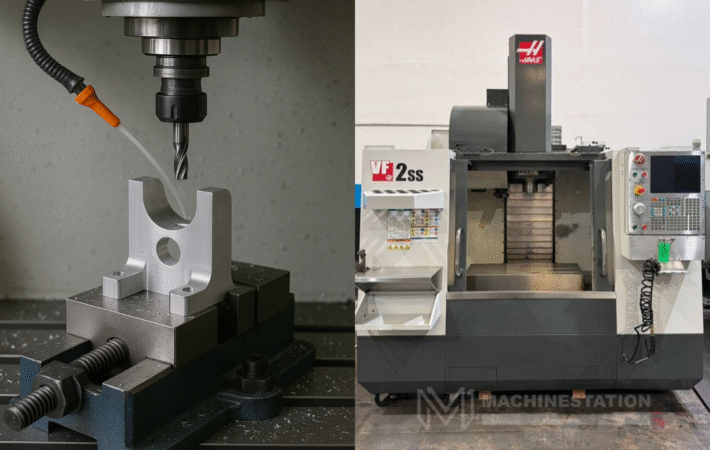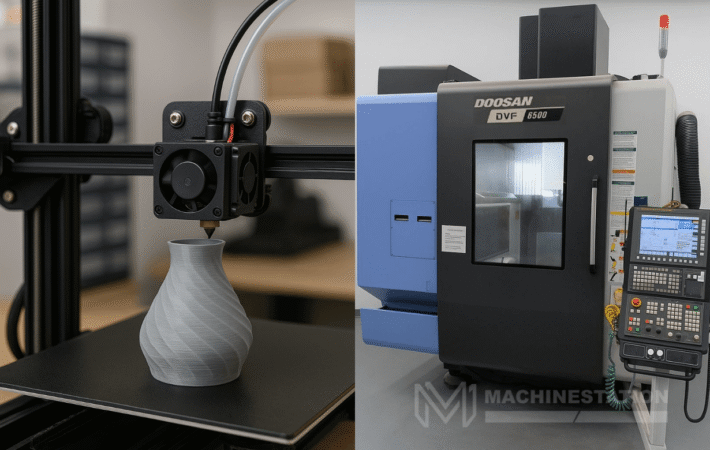In the world of machining, different types of machines are used for different reasons. Some stand out because of the materials they can work with and some stand out for the kind of product they can produce. Two of the most common types of CNC machines that are used by different companies around the world are CNC mills and CNC lathes. Both of these machines are highly efficient for the job they are meant to do. But through this blog, we will try to understand whether a mill can do the job of the lathe. If you are curious about this topic then let’s continue with us till the end and we will help you out.
Understanding the basics:
Let’s start by finding out the main definition of these two machine types and what they do:
CNC Mills: CNC mills are machines that use rotatory cutters to cut materials from a stationary workpiece to give it the desired shape. In these machines, the workpiece is attached to one place with the help of a work-holding tool while the cutting machine moves around it to remove materials and give the right shape.
CNC Lathes: In the CNC lathes, the whole cutting process is done in the reverse way where the cutting tool is held in one place by the tool-holding device while the workpiece rotates around it to get the cutting done and get the desired shape. These machines are ideal for making parts of cylindrical, round, or conical shape objects.
Main differences between CNC mill and lathe:
Here’s a comprehensive chart of the main differences between CNC mills and CNC lathes:
| Feature | CNC Mill | CNC Lathe |
| Workpiece Movement | Stationary | Rotating |
| Tool Movement | Multi-axis (X, Y, Z, often more) | Typically two axes (X, Z) |
| Ideal Shapes | Prismatic, flat, angular, complex geometry | Cylindrical, round, conical |
| Typical Products | Brackets, housings, plates, molds | Shafts, rods, bushings, pulleys |
| Setup Complexity | Higher (multi-axis alignment) | Lower (single-axis clamping) |
| Precision | High for complex details | High for symmetrical round parts |
| Production Speed | Fast for complex shapes | Fast for round parts |
| Cost | Generally higher (machine & tooling) | Lower for basic turning |
| Space Requirements | Larger footprint | Smaller footprint |
Strength of CNC mills:
Let’s know why CNC machines are used and what are the strengths that they bring to your manufacturing plant:
- CNC mills can manufacture a variety of shapes, which include 3D contours, pockets, and other parts with intricate designs.
- Some of the modern CNC mills feature a high number of axes, which can be 4, 5, and even 6 axes, helping with multi-sided machining in just one setup.
- Their flexibility helps in different works like prototyping and small scale manufacturing.
Strength of CNC lathes:
Now, we know about the strengths of CNC mills, it is time to know what are the strengths of a CNC lathe:
- Lathes have unmatched capabilities of building circular or cylindrical shaped parts with high precision.
- They mostly have a faster material removal rate compared to CNC milling machines.
- The CNC lathes are straightforward and are very easy to set up and operate.
Can a CNC mill do the work of a lathe?
Technically, yes, a CNC mill can do some of the work of a CNC lathe. But there are some limitations too. The CNC mills can do some basic turning operations like lathes using rotatory tables and fixtures. Here are some reasons why one should use a CNC mill instead of a CNC lathe:
- Reduced setups: If you don’t need complex circular or cylindrical shapes, then CNC mills can make the simple one in one setup without bringing a new lathe for those products. This also eliminates the need to transfer a workpiece from a CNC mill to a CNC lathe. Also if a complex part needs both cylindrical design and intricate milled slots or holes then that can be done using milling machines in one shot.
- Complex geometries: The multi axis CNC mills are designed to work on complex geometries that are generally difficult for other machines to make. Parts with non-symmetrical parts on cylindrical bodies would be easily made using CNC mills rather than a CNC lathe. Lathe, on the other hand, can only work on products that have rotational symmetry.
- Tooling versatility: CNC mills have tool changers that can hold a wide range of cutting tools, like end mills, ball mills, taps, and reamers. While a CNC lathe primarily uses single point cutting tools, a milling machine offers a much wider range of cutting options over lathes.
Where do lathes become necessary?
We have discussed where we can use a CNC milling machine in place of a CNC lathe. Now, let’s know where lathes become necessary over CNC mills:
- High volume circular parts production: If you are in a business where you need to make circular or cylindrical parts in high volume then you should go with CNC lathes, as they are best for that job and also bring high accuracy in making such products.
- Want to save cost and time: The setting up time of CNC milling machines is high compared to lathes, so if you want to save that time then you should buy lathes. Also, CNC lathes are cheaper in comparison to CNC mills, so it saves your upfront costs too.
- Material removal rate during operations: CNC lathes are superior when it comes to material removal speed, which makes the turning operations of the CNC lathes more efficient compared to the operations of CNC mills. The cutting forces are far more equally distributed and chips are also more efficiently evacuated.
The rise of Mill Turn machines:
Can a CNC mill replace a CNC lathe? This question has given birth to a new kind of machine which are known as mill turn machines, which are the true hybrid answer to that question. These machines feature a lathe-like spindle, to be used for turning operations and a milling spindle that can help perform milling operations on the rotating workpiece.
Mill turn CNC machines are getting popular all around the world because of their different benefits like the ability to fully machine a part with both turned and milled features in a single clamping, it reduces the setup time by eliminating the need for multiple setups, bringing more accuracy by reducing the number of steps, and they are ideal for handling complex parts.
Conclusion:
Both CNC mills and lathes have their advantages and disadvantages so it is very tough to choose one among them for a function that needs both of their features and that is why CNC mill turn machines can be the only right answer for those problems. If you are thinking of buying any Used CNC Lathes or Used CNC Mills, then you must check our collection.






